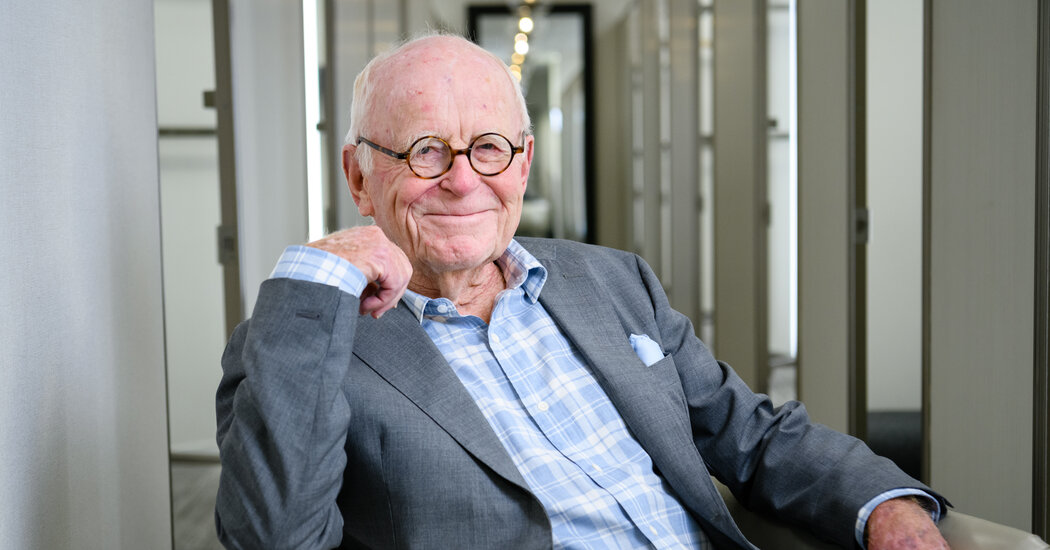Bruce Nordstrom, who along with three other members of his family transformed a small chain of Pacific Northwest shoe stores into an international fashion retail giant with more than 150 locations worldwide, died on Saturday at his home in Seattle. He was 90.
His death was confirmed by a company spokeswoman.
As a grandson of John W. Nordstrom, the Swedish immigrant who founded the company, Mr. Nordstrom was a member of the third generation of the family to run the company jointly, sharing power and making decisions by consensus — an unusual but successful Nordstrom tradition that continues to this day.
He shared leadership with his cousins John N. Nordstrom and Jim Nordstrom, who were brothers, and Jack McMillan, who was married to their cousin Loyal Nordstrom.
Management by committee is considered a business school formula for disaster, but the Nordstrom family, starting with Bruce’s father, Everett, and Everett’s brothers Elmer and Lloyd, decided that they could be more effective as co-leaders of the company, which was founded in 1901 in Seattle.
When Lloyd Nordstrom called 30-year-old Bruce into his office in 1963 and named him president of the company, the younger Mr. Nordstrom accepted the post. But he soon decided that he would emulate his father’s generation and share leadership with his three relatives.
“Obviously, the arrangement worked out great,” Bruce Nordstrom wrote in his 2007 autobiography, “Leave It Better Than You Found It.” “It was marvelous for them and it was marvelous for me because it felt like a weight had been taken off my shoulders.”
Robert Spector, author of “The Nordstrom Way,” a 1996 book about the company’s vaunted reputation for customer service, noted that Bruce Nordstrom was “the nominal leader of the group.” But the company’s egalitarian system, with each executive in charge of an area of expertise, worked because of a combination of pride and humility, with the company always coming first before the needs of any individual.
“Bruce was a very humble guy but a very prideful guy,” Mr. Spector said in an interview for this obituary in 2019. “He was low-key and didn’t take himself too seriously. But he wanted to win.”
Starting with seven shoe stores in Seattle and Portland, Ore., the family rapidly expanded the chain from the late 1970s through the ’80s, extending to California and then across the country while adding a full line of clothing and accessories. What had been a regional shoe-store chain with less than $40 million in sales became a retail behemoth, operating 182 stores in 28 states and offering online shopping in 30 countries, with sales of more than $9 billion.
When the family opened an outlet in Southern California in 1978, Bruce Nordstrom and his cousins encountered a wave of skepticism about their planned growth. “There were some people around at the time who said: ‘Why are you going to mess it up by opening there? You guys do all right in the Northwest, but it’s a different, more sophisticated customer’” in California “‘and you are going to blow it,’” Mr. Nordstrom said in an interview with Footwear News in 2018.
Though mild-mannered, Mr. Nordstrom was nonetheless an ambitious and determined leader, and he said his response to that negativity was to work harder. “I liked proving that we could really do something,” he said. “We evolved, moved around and had success. Success gave us the confidence to push on.”
Mr. Nordstrom acknowledged that the company’s leaders had occasional differences. “We don’t agree all the time,” he told Footwear News, “but we vote when we need to decide things. Sometimes, behind closed doors, there might be smoke. But we are committed to finding a solution. When we walk out, we walk out as one.”
Bruce Allen Nordstrom was born in Seattle on Oct. 1, 1933. His mother, Elizabeth (Jones) Nordstrom, who was known as Libby, was an accomplished singer who performed on the radio.
During World War II, when he was 9, Bruce began working at the Nordstrom shoe store in downtown Seattle on Saturdays and in the summers. He swept floors and broke down cardboard boxes for 25 cents an hour. Standing in line with the other employees to collect his wages, he recalled in his memoir, he was proud to be a paid staff member.
He went on to receive a bachelor’s degree from the University of Washington in Seattle, where most of the Nordstrom men graduated, and where he rowed for the renowned crew team. While finishing college, he met Fran Wakeman, a freshman from Seattle, and after an on-again, off-again romance for years, the couple married. They had three sons, Blake, Peter and Erik, all of whom went to work for Nordstrom.
After graduating from the university in 1955, Mr. Nordstrom joined the Army and served for six months as a lieutenant at Fort Bliss in El Paso, Texas. When he returned to Seattle, he went to work running one of the company’s stores. His future in management was set.
Mr. Nordstrom retired in 2006 as chairman but continued to be a vital presence in the company’s stores. Forbes this year estimated his wealth at $1 billion.
Fran Nordstrom died in 1984. Four years later, Mr. Nordstrom married Jeannie O’Roark. His oldest son, Blake, died of cancer in 2019.
He is survived by his wife; his sons Peter and Erik, who continue to help run the company; a sister, Anne Gittinger; and seven grandchildren.
Alex Traub contributed reporting.




